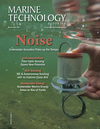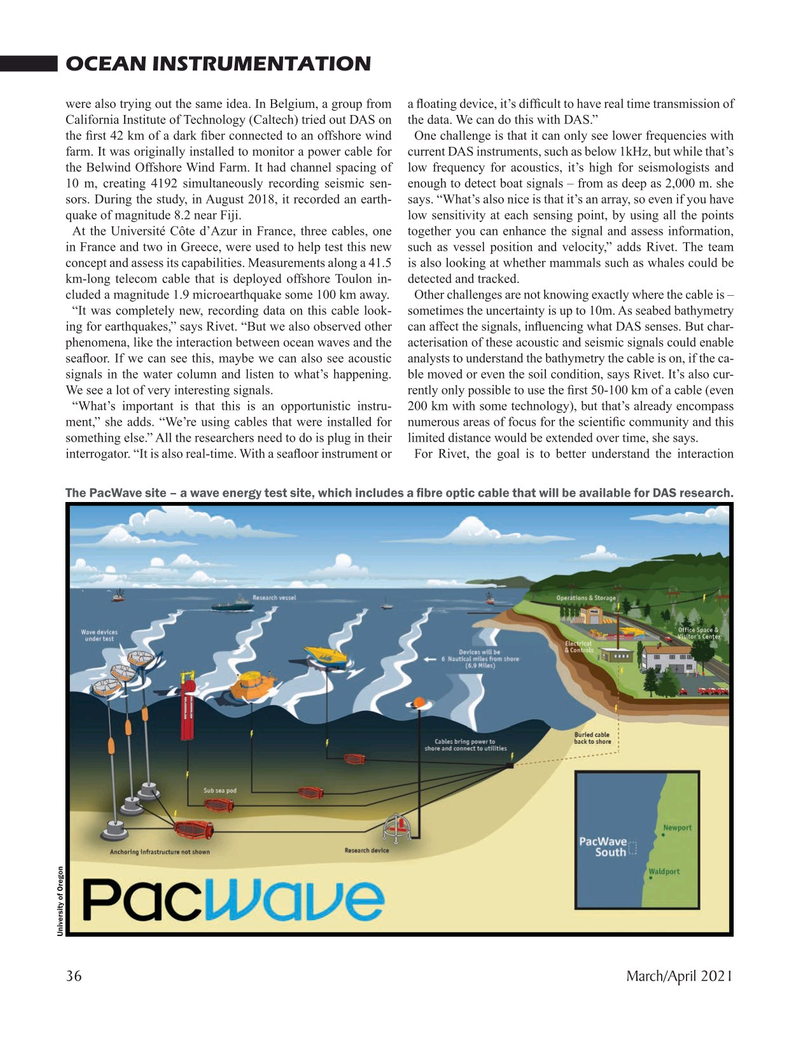
Page 36: of Marine Technology Magazine (March 2021)
Oceanographic Instrumentation & Sensors
Read this page in Pdf, Flash or Html5 edition of March 2021 Marine Technology Magazine
OCEAN INSTRUMENTATION were also trying out the same idea. In Belgium, a group from a ? oating device, it’s dif? cult to have real time transmission of
California Institute of Technology (Caltech) tried out DAS on the data. We can do this with DAS.” the ? rst 42 km of a dark ? ber connected to an offshore wind One challenge is that it can only see lower frequencies with farm. It was originally installed to monitor a power cable for current DAS instruments, such as below 1kHz, but while that’s the Belwind Offshore Wind Farm. It had channel spacing of low frequency for acoustics, it’s high for seismologists and 10 m, creating 4192 simultaneously recording seismic sen- enough to detect boat signals – from as deep as 2,000 m. she sors. During the study, in August 2018, it recorded an earth- says. “What’s also nice is that it’s an array, so even if you have quake of magnitude 8.2 near Fiji. low sensitivity at each sensing point, by using all the points
At the Université Côte d’Azur in France, three cables, one together you can enhance the signal and assess information, in France and two in Greece, were used to help test this new such as vessel position and velocity,” adds Rivet. The team concept and assess its capabilities. Measurements along a 41.5 is also looking at whether mammals such as whales could be km-long telecom cable that is deployed offshore Toulon in- detected and tracked.
cluded a magnitude 1.9 microearthquake some 100 km away. Other challenges are not knowing exactly where the cable is – “It was completely new, recording data on this cable look- sometimes the uncertainty is up to 10m. As seabed bathymetry ing for earthquakes,” says Rivet. “But we also observed other can affect the signals, in? uencing what DAS senses. But char- phenomena, like the interaction between ocean waves and the acterisation of these acoustic and seismic signals could enable sea? oor. If we can see this, maybe we can also see acoustic analysts to understand the bathymetry the cable is on, if the ca- signals in the water column and listen to what’s happening. ble moved or even the soil condition, says Rivet. It’s also cur-
We see a lot of very interesting signals. rently only possible to use the ? rst 50-100 km of a cable (even “What’s important is that this is an opportunistic instru- 200 km with some technology), but that’s already encompass ment,” she adds. “We’re using cables that were installed for numerous areas of focus for the scienti? c community and this something else.” All the researchers need to do is plug in their limited distance would be extended over time, she says.
interrogator. “It is also real-time. With a sea? oor instrument or For Rivet, the goal is to better understand the interaction
The PacWave site – a wave energy test site, which includes a ? bre optic cable that will be available for DAS research.
University of Oregon 36 March/April 2021
MTR #3 (34-49).indd 36 3/22/2021 9:14:15 PM

 35
35

 37
37
